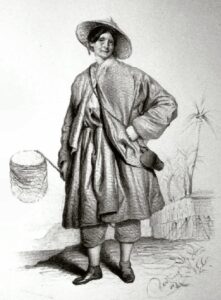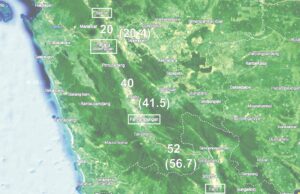I first came across Ida Pfeiffer while reading about the visit of the corvette Uranie to Rio de Janeiro. Although she was only a few years younger than Rose de Freycinet, Ida did not arrive in Rio until more than thirty years after Rose had left it for the second time; she was, nonetheless, a great help to me with the 19th Century geography of the outskirts of the city and its hinterland. In her writing she showed herself, even in that relatively European environment, as a woman who let very little get in her way, and one with a sharp eye for detail. On reading more about her I discovered that, once free of family obligations (she had no hesitation in leaving behind in Vienna two sons in their early twenties) she made two complete circuits of the globe and in doing so visited an extraordinary number of places. Unlike most of the woman travellers of the 19th Century, she travelled light, determined to have no more baggage than she could, at a pinch, carry herself. In the East Indies in 1852, when she was already 55 years old, she visited the Dyaks of Borneo and, of more direct interest to me, the Bataks of Sumatra, a people to which many of my geological colleagues in Indonesian had belonged. That made me want to learn more about Ida’s travels among them, and I decided to try to find out where she went and how she got there. She was scrupulous about recording the names of the places in which she stayed, and even some of those she just passed through, as well as the distances between them and the dates of her visits, and I had the internet resources of Google Earth and Mapcarta at my disposal. Of the two, Mapcarta provided many more place names, but there were actually fewer correspondences with the names that Ida had used (or perhaps, that her translators had used, because I have looked only at the English translation of her book, published by Longman, Green in 1855).

Ida Pfeiffer, dressed for insect collecting in the tropics. Lithograph by Adolf Dauthage, downloaded from Wikimedia Commomns
They are interesting people, the Bataks (or, as Ida called them, the Battakers). They are in some ways typical of the early inhabitants of the Indonesian islands, who in many areas retreated into the hills as the Malays moved in and occupied the coasts, but they have their own unique idiosyncracies. They are mainly Christians, in a country that is dominantly Muslim, and demonstrate their contrariness in a multitude of other ways. They are egalitarians and their rajas were merely first among equals, and they not afraid to speak their minds on any issue. Their clan or marga is a vital part of their identity; to adapt an old saying, you can take a Situmorang out of his marga but you will never take the marga out of a Situmorang. In modern Indonesia they are concentrated in certain professions, including the earth sciences, where a mindset that allows received opinion to be disregarded in favour of theories formed on the basis of typically incomplete data has its merits, and its drawbacks.
Such attitudes were of minor significance to Ida; far more important to her was the Bataks’ well-deserved reputation for eating people. Nonetheless she was determined to go, and her starting point of Fort Kock can be easily identified. It was the Dutch fort around which, and over which, the town of Bukit Tinggi has since been built; it lies in the heart of the country of the Minangkabau, who are reputedly the most populous matriarchal society in the world, which they somehow manage to combine with being followers of Islam.
As Ida prepared to leave the safety of Fort Kock and set out for the lands of the Bataks, she had just one concern.
I only wanted to be satisfied as to one thing, namely, whether it was true, as many travellers asserted, that the Battakers did not put their victims out of their pain at once, but tied them living to stakes, and, cutting pieces of them, consumed them by degrees with tobacco and salt. The idea of this slow torture did a little frighten me ; but my hearers assured me, with one accord, that this was only done to those who were regarded as criminals of a deep dye, and who had been on that account condemned to death. Prisoners of war are tied to a tree and beheaded at once.
So that was all right, then. Reassured, she entered the fringes of the land of the Bataks. Much of the route she travelled on horseback, but she was not impressed by her mounts.
Such horses they were! In no other part of the world have I ever met with such awkward beasts, They stumbled at every stone, tumbled into every hole, looked out on the bridges, seemingly, for the rotten places, on purpose to put their feet upon them, and made a point of being desperately frightened on all occasions —even at a large leaf, if it happened to be in the way, I am not giving these troublesome brutes a bad character without having had abundant means of forming an opinion, for I have ridden in Sumatra as few men have done; and as I had to be continually changing horses, I had a very extensive acquaintance among them
On July 27 she reached the small town of Panti, impressed by the beauty of the surroundings and the abundant traces of elephants and tigers she saw en route, but less so by the male half of the population, who, she wrote, did little but loiter around chewing sirih (the leaves of the Piper betel), gambling and cock-fighting, and playing a game involving throwing small stones into slightly larger holes. Even this was only for the more energetic, since ‘they can make themselves comfortable doing absolutely nothing at all’. In Ida the work ethic instilled by her tyrannical father ran strong.

Ida’s route from Panti to Siprok.(Image, Google Earth). The modern road largely follows her route along the valley of the Tamur, which is the trace of the Sumatra Fault Zone in this region. White rectangles indicate places with names that can be found in Ida’s account. Numbers are her estimates of the distances, in miles, between these places and (in brackets), the same distances as measured in Google Maps.
The next day she travelled 13 miles, leaving the Minangkabau behind and entering the land of the Mandailing, a group often associated with the Angkola Bataks but distinguished from them by, among other things, their adoption of a very rigorous form of Islam. A further ten mile ride on 29 July brought her to Muarasipongi, which she described as being ‘in the midst of the Battaker country’ but which had by that time been subject to the Dutch for more than ten years. There she found a flourishing market in selling gold panned from the rivers, with the proceeds mainly expended on betting on cock-fighting, in Spanish dollars. From the Dutch Resident she received an interesting insight into the Batak rejection of Islam. He told her that there had been an attempt by Islamic missionaries, who would probably have come from Aceh, to impose their religion with armed force, with very negative results. Dislike of Islam had evidently not yet led to the acceptance of Christianity because, according to him, two American missionaries had recently been killed and eaten. It was in this town that Ida sought reassurance regarding the Batak treatment of prisoners prior to their ingestion; in speaking of it, the Resident rather implied that he had himself enjoyed some of those feasts.
On 31 July, Ida reached Fort Elant at Pamyambugan after a two-day journey of about 30 miles. She was still following a road created by the Dutch (for moving troops as much as for supporting commerce, she suspected) and there may even have been distance markers along the way. because, as the map shows, her distance estimates were close to the truth. While at the fort she took theopportunity to put down on paper some of her thoughts on the treatment of indigenous peoples by their European rulers, not just in Sumatra but as general pattern in the colonies she had visited. Her very critical attitude to European behaviour did not prevent her from writing elsewhere of how suitable some of the country through which she passed would be for European settlement.
Two days later, on 2 August, Ida reached Padang Sidempuan. Although she still had several days to travel to reach the acknowledged frontier between the Dutch-contolled and the ‘free’ Bataks, this was the last European outpost she would pass through, so it was fitting that on the day of her arrival she was able to enjoy a rubber of whist. She stayed three days before setting out to cover the twenty miles to Sipirok, where today the roads divide to pass either side of Lake Toba, which had been her primary objective but which was still some distance away. While taking ‘a cordial farewell of perhaps the last Europeans whom in this world I shall ever see’, she he left behind her ‘some papers that were to be sent to my family in case I should never come back’.
She was, at all times, a realist.
